 Over recent decades, availability of suitable barn owl nesting cavities has reduced primarily due to loss of large trees with hollows, and modernisation and enclosure of farm buildings. Providing nest boxes within or near to suitable habitat can help to increase breeding success and support local barn owl populations.
Over recent decades, availability of suitable barn owl nesting cavities has reduced primarily due to loss of large trees with hollows, and modernisation and enclosure of farm buildings. Providing nest boxes within or near to suitable habitat can help to increase breeding success and support local barn owl populations.
There are various factors to take into account when siting your barn owl nest box:
Habitat to consider...
Boxes should be located within or close to suitable foraging habitat where main prey items such as voles, shrews and mice are likely to be present. This will include open habitat, predominantly farmland with features such as hedgerows, banks, rough grassland, ditches and spinneys.
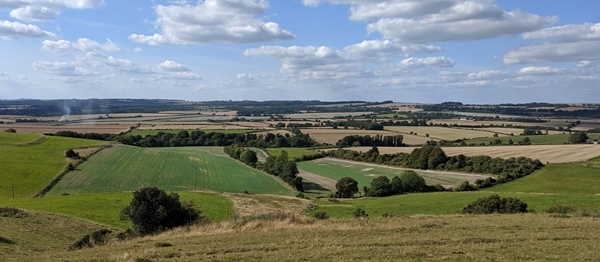 Farmland landscape showing suitable barn owl habitat of rough grassland, hedgerows and spinneys, etc.
Farmland landscape showing suitable barn owl habitat of rough grassland, hedgerows and spinneys, etc.
Building or tree?
As a first choice, boxes are best placed inside buildings to provide protection against inclement weather and provide desirable dark conditions, as well as reducing the possibility of doves or jackdaws occupying the box. However, if there is no inside option, boxes which are made and treated for external use can be positioned on the outside of barns, on an isolated tree within a field, or at the very edge of woodland that faces out onto an expanse of suitable habitat, but without facing into a prevailing wind.
Alternatively, boxes can be mounted on a pole, but you should ensure a platform is provided all way round the box for owlets to exercise their wings and fledge from, as well as making the pole predator-proof by choosing a rounded metal design.
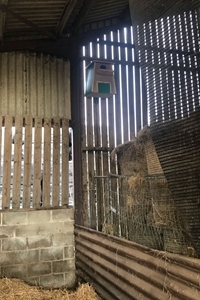
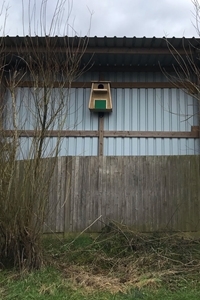
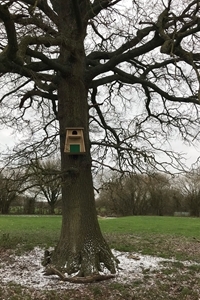
Barn owl nest boxes erected in three suitable locations (left to right):
Inside a dry barn; outside a barn looking out onto open, suitable habitat; and on an isolated standard tree.
What makes a barn owl investigate a nesting/roosting site?
Barn owls looking for potential nest sites are drawn to investigate a box’s dark entry hole, so make sure it is clearly visible to owls that are passing or entering a barn in search of prey. A clear, unobscured entry hole will also allow for an easy flight path in. If erecting a nest box on a tree in winter, remember to lightly prune any branches that may conceal the box once the leaves are back on the trees.
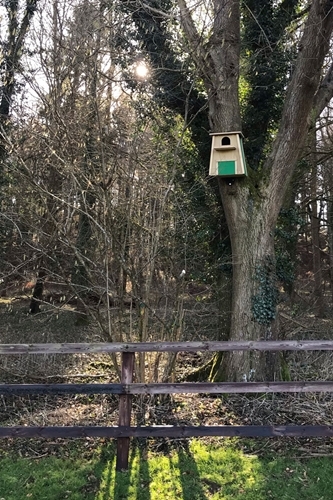 Barn owl nest box on the very edge of woodland, looking out
Barn owl nest box on the very edge of woodland, looking out
onto an open expanse of rough grassland. This box has a hazel
stand in front, which was trimmed to ensure the entrance hole
is not concealed once vegetation has grown back.
How high?
The height of a barn owl nest box is also important, with an entry hole that is at least 3m off the ground. This height will provide greater protection from predators, which will increase the likelihood that a barn owl will occupy the box, as well as being at a convenient position for a barn owl to enter at its natural flight height. It is also worth considering how large machinery might interact with any indoor barn boxes and if hay/straw bales will be placed high within a barn, which could damage a nest box.
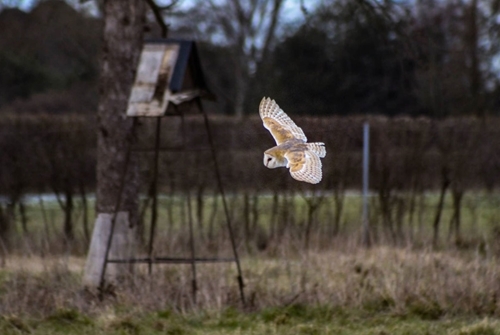 Barn owls typically fly low, so a box erected at 3-5m will be suitable, as well as allowing for
Barn owls typically fly low, so a box erected at 3-5m will be suitable, as well as allowing for
access to maintain and clean the box during the winter months. (© Samantha Skinner - @_wild_ish)
How much disturbance is too much?
More than other UK owl species, the barn owl is more closely associated with humans and their buildings, and usually tolerate a higher degree of disturbance. However, when erecting a new barn owl nest box it is best to choose a quiet space with as little disturbance as possible, and away from frequent activity.
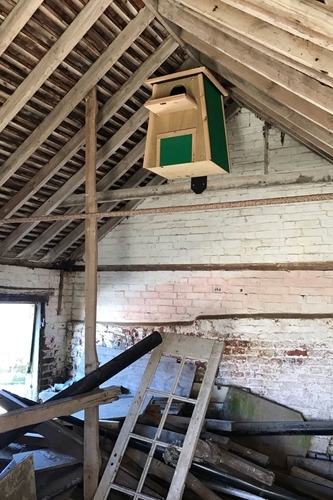 A barn owl nest box erected inside a disused
A barn owl nest box erected inside a disused
barn, which will minimise disturbance.
Be mindful of major roads
Unfortunately, 90% of barn owl casualties take place on major roads (usually dispersing juveniles), therefore it is important to site your barn owl nest box at least 500m away from any major, unscreened roads.
Barn owls will be attracted to the rough grass verges of main roads, and unless the roads are closely screened by tall vegetation to encourage owls to fly up and over traffic, their typical low flight path can direct them straight into the line of moving vehicles.
The five species of owl in the UK have different needs when it comes to nest box design. Look out for our next blog, when we will be sharing details on the specific design of a barn owl nest box.
If you would like guidance or advice on where to site your barn owl nest box, please contact project Research Assistant Jodie Case (jcase@gwct.org.uk).